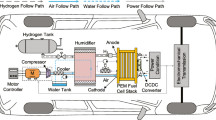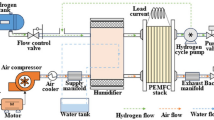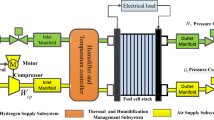Abstract
Polymer electrolyte membrane (PEM) fuel cell system is usually affected negatively by external disturbance, model uncertainties and unmeasured variables. In this paper, a robust composite adaptive neural network controller using high-gain observer is proposed to achieve stable oxygen excess ratio control for PEM fuel cell air management system. First, the derivatives of system output, which are unavailable due to the limited sensors, are estimated via high-gain observer. Then, a neural network is adopted to estimate the unknown system dynamics and the additional robust term is used to attenuate the compound disturbance including unknown external disturbance and neural network approximation error. Finally, a composite adaptive updating laws are constructed by utilizing estimated tracking error and modeling error to improve the tracking performance. In contrast to the existing controllers applied in PEM fuel cell air management system, this controller has a better control performance in the practical application. By means of Lyapunov stability analysis, it is theoretically proved that the system tracking error is uniformly ultimately bounded. The effectiveness and practicability of the proposed controller are validated by hardware-in-loop experiment.


















Similar content being viewed by others
Explore related subjects
Discover the latest articles and news from researchers in related subjects, suggested using machine learning.Abbreviations
- PEM:
-
Polymer electrolyte membrane
- OER:
-
Oxygen excess ratio
- HIL:
-
Hardware-in-loop
- RBFNN:
-
Radial basis function neural network
- CARBFNN:
-
Composite adaptive radial basis function neural network
- PID:
-
Proportion–integral–derivative
- RMSE:
-
Root mean square error
- SD:
-
Standard deviation
References
Ou K, Wang YX, Li ZZ, Shen YD, Xuan DJ (2015) Feedforward fuzzy-pid control for air flow regulation of pem fuel cell system. Int J Hydrog Energy 40(11):11686–11695
Wang YX, Kim YB (2014) Real-time control for air excess ratio of a pem fuel cell system. IEEE ASME Trans Mechatron 19(3):852–861
Cardenas A, Agbossou K, Henao N (2015) Development of power interface with fpga-based adaptive control for pem-fc system. IEEE Trans Energy Convers 30(1):296–306
Jayakumar A, Chalmers A, Lie TT (2017) Review of prospects for adoption of fuel cell electric vehicles in new zealand. IET Electr Syst Transp 7(4):259–266
Pukrushpan JT, Stefanopoulou AG, Peng H (2004) Control of fuel cell power systems. Springer, London
Suh KW (2006) Modeling analysis and control of fuel cell hybrid power systems
Na WK, Gou B (2008) Feedback linearization-based nonlinear control for PEMfuel cells. IEEE Trans Energy Convers 23(1):179–190
Arce A, Real AJD, Bordons C, Ramirez DR (2010) Real-time implementation of a constrained mpc for efficient airflow control in a pem fuel cell. IEEE Trans Ind Electron 57(6):1892–1905
Niknezhadi A, Miguel A-F, Kunusch C, Carlos O-M (2011) Design and implementation of LQR/LQG strategies for oxygen stoichiometry control in PEM fuel cells based systems. J Power Sour 196(9):4277–4282
Liu D, Yang GH (2019) Prescribed performance model-free adaptive integral sliding mode control for discrete-time nonlinear systems. IEEE Trans Neural Netw Learn Syst 30(7):2222–2230
Park G, Gajic Z (2011) A simple sliding mode controller of a fifth-order nonlinear pem fuel cell model. IEEE Trans Energy Convers 29(1):65–71
Talj RJ, Ortega R, Hilairet M (2009) A controller tuning methodology for the air supply system of a PEM fuel-cell system with guaranteed stability properties. Int J Control 82(9):1706–1719
Talj RJ, Hissel D, Ortega R, Becherif M, Hilairet M (2010) Experimental validation of a pem fuel-cell reduced-order model and a moto-compressor higher order sliding-mode control. IEEE Trans Ind Electron 57(6):1906–1913
Kunusch C, Puleston P, Mayosky M, Riera J (2009) Sliding mode strategy for PEM fuel cells stacks breathing control using a super-twisting algorithm. IEEE Trans Control Syst Technol 17(1):167–174
Almeida PEM, Simoes MG (2005) Neural optimal control of PEM fuel cells with parametric CMAC network. IEEE Trans Ind Appl 41(1):237–245
Rezazadeh A, Askarzadeh A, Sedighizadeh M (2011) Adaptive inverse control of proton exchange membrane fuel cell using RBF neural network. Int J Electrochem Sci 6(8):3105–3117
Wang YL, Wang YF, Zhang HK (2019) Robust adaptive control of PEMFC air supply system based on radical basis function neural network. Trans ASME J Dyn Syst Meas Control 141(6):064503–064503-7
Erlic M, Lu WS (1995) A reduced-order adaptive velocity observer for manipulator control. IEEE Trans Robot Autom 11(2):293–303
Tee KP, Ge SS (2006) Control of fully actuated ocean surface vessels using a class of feedforward approximators. IEEE Trans Control Syst Technol 14(4):750–756
Ge SS, Zhang J (2003) Neural network control of nonaffine nonlinear system with zero dynamics by state and output feedback. IEEE Trans Neural Netw 14(4):900–918
Behtash S (1990) Robust output tracking for non-linear systems. Int J Control 51(6):1381–1407
Modares H, Rowhanimanesh A, Karimpour A (2010) A novel adaptive neural sliding mode control for systems with unknown dynamics. In: Proceedings of the third international workshop on advanced computational intelligence, Suzhou
Hojati M, Gazor S (2002) Hybrid adaptive fuzzy identification and control of nonlinear systems. IEEE Trans Fuzzy Syst 10(2):198–210
Bellomo D, Naso D, Babuška R (2008) Adaptive fuzzy control of a non-linear servo-drive: theory and experimental results. Eng Appl Artif Intell 21(6):846–857
Chen J, Liu Z, Wang F, Ouyang Q, Su H (2017) Optimal oxygen excess ratio control for pem fuel cells. IEEE Trans Control Syst Technol 26(5):1711–1721
Zhao T, Li FF (2012) Neural network-based adaptive output feedback control for MIMO non-affine systems. Neural Comput Appl 21(1):145–151
Yang S, Tang Y, Xu Z, Zagrodnik M, Amit G, Wang P (2017) Feedback linearization-based current control strategy for modular multilevel converters. IEEE Trans Power Electron 33(1):161–174
Khalil HK (2004) Nonlinear systems. Prentice-Hall, New York
Modares H, Lewis FL, Naghibi-Sistani M (2013) Adaptive optimal control of unknown constrained-input systems using policy iteration and neural networks. IEEE Trans Neural Netw Learn Syst 24(10):1513–1525
Pham VC, Wang YN (2016) Adaptive trajectory tracking neural network control with robust compensator for robot manipulators. Neural Comput Appl 27(2):525–536
Li TS, Duan SK, Liu J, Wang LD (2018) An improved design of RBF neural network control algorithm based on spintronic memristor crossbar array. Neural Comput Appl 30(6):1939–1946
Atassi AN, Khalil HK (2011) Separation results for the stabilization of nonlinear systems using different high-gain observer designs. Syst Control Lett 39(3):183–191
Laghrouche S, Mohamed H, Fayez S (2015) Control of pemfc air-feed system using lyapunov-based robust and adaptive higher order sliding mode control. IEEE Trans Control Syst Technol 23(4):1594–1601
Deng HW, Li Q, Chen WR, Zhang G (2018) High order sliding mode observer-based oer control for pem fuel cell air-feed system. IEEE Trans Energy Convers 33(1):232–244
Abd-Elazim SM, Ali ES (2018) Load frequency controller design of a two-area system composing of PV grid and thermal generator via firefly algorithm. Neural Comput Appl 30(2):607–616
Yao JJ, Jiang GL, Gao S, Yan H, Di DT (2013) Particle swarm optimization-based neural network control for an electro-hydraulic servo system. J Vib Control 20(9):1369–1377
Oshaba AS, Ali ES, Abd-Elazim SM (2017) PI controller design for MPPT of photovoltaic system supplying SRM via BAT search algorithm. Neural Comput Appl 28(4):651–667
Funding
Natural Science Foundation of China (Grand No. 51775103).
Author information
Authors and Affiliations
Corresponding author
Ethics declarations
Conflict of interest
The authors declared that they have no conflicts of interest to this work. We declare that we do not have any commercial or associative interest that represents a conflict of interest in connection with the work submitted.
Additional information
Publisher's Note
Springer Nature remains neutral with regard to jurisdictional claims in published maps and institutional affiliations.
Rights and permissions
About this article
Cite this article
Wang, Y., Wang, Y. & Chen, G. Robust composite adaptive neural network control for air management system of PEM fuel cell based on high-gain observer. Neural Comput & Applic 32, 10229–10243 (2020). https://doi.org/10.1007/s00521-019-04561-7
Received:
Accepted:
Published:
Issue Date:
DOI: https://doi.org/10.1007/s00521-019-04561-7




